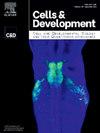口腔源性间充质干细胞/间质细胞的内皮分化。
IF 2
4区 生物学
Q4 Biochemistry, Genetics and Molecular Biology
引用次数: 0
摘要
血管系统的快速构建确保了口腔和颅面组织再生的组织工程结构的存活和正常功能。通过含有内皮细胞(ECs)和其他支持细胞的共培养系统实现血管化比宿主血管生成长进更有利,因为它允许更快的血管形成甚至预血管化。在不同来源的内皮细胞中,口腔来源的间充质干细胞/基质细胞(MSCs)的多分化能力表明它们有可能产生用于血管组织工程的自体内皮细胞。考虑到组织工程对血管化的兴趣日益浓厚,本文旨在对人口腔来源的间充质干细胞的内皮分化进行全面的综述。具体来说,作者首先仔细审查了使用msc衍生的内皮细胞的科学依据和生物学可行性,然后探索了体外和体内内皮分化的标准和评估,并汇编了内皮分化的不同策略及其潜在机制。随后,还讨论了与实际考虑相关的不同方面,包括内皮分化方案/策略的特征和优化、培养条件、细胞来源和亚群,以指导分化方法的选择,并了解影响分化结果的因素。最后,还提供了目前的技术,生物学和临床限制和未来的展望。全面了解这些主题可能为从口腔来源的MSCs诱导功能成熟的内皮细胞奠定基础,这必将为口腔和颅面组织再生提供临床价值。本文章由计算机程序翻译,如有差异,请以英文原文为准。
Endothelial differentiation of Oral cavity-derived mesenchymal stem/stromal cells
A rapid construction of vasculature ensures the survival and proper functions of tissue-engineered constructs for oral and craniofacial tissue regeneration. Vascularization achieved via a co-culture system containing endothelial cells (ECs) and other supporting cells is more advantageous compared to host angiogenic ingrowth, as it allows faster vessel formation or even prevascularization. Among different sources of ECs, the multidifferentiation capacity of oral cavity-derived mesenchymal stem/stromal cells (MSCs) indicates their potential to give rise to autologous ECs for use in vascular tissue engineering. Considering the growing interest in vascularization in tissue engineering, this review intends to provide a comprehensive overview of the endothelial differentiation of human oral cavity-derived MSCs. Specifically, the author begins by scrutinizing the scientific justification and biological feasibility of employing MSC-derived ECs, followed by an exploration of the criteria and assessment of both in vitro and in vivo endothelial differentiation and a compilation of different strategies for endothelial differentiation induction and their underlying mechanisms. Subsequently, the different aspects pertinent to the practical considerations, including the characteristics and optimization of endothelial differentiation protocols/strategies, culture conditions, and cell origin and subpopulations, are also discussed to guide the selection of the differentiation approach and to understand the factors affecting the differentiation outcome. Finally, the present technical, biological, and clinical constraints and future perspectives are also provided. Gaining a comprehensive knowledge of these topics may provide a cornerstone for the potential derivation of functional and mature ECs from oral cavity-derived MSCs, which will certainly provide clinical value for oral and craniofacial tissue regeneration.
求助全文
通过发布文献求助,成功后即可免费获取论文全文。
去求助
来源期刊

Cells and Development
Biochemistry, Genetics and Molecular Biology-Developmental Biology
CiteScore
2.90
自引率
0.00%
发文量
33
审稿时长
41 days
 求助内容:
求助内容: 应助结果提醒方式:
应助结果提醒方式:


